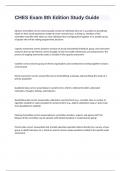CHES Exam 8th Edition Study Guide
Advisory Committee correct answersusually consists of individuals who are in a position to periodically
report on their actual experiences related to some common issue. In doing so, members of this
committee may offer their advice to a key individual who is bringing them together or to another group
of people who will be making programmatic decisions
Capacity assessment correct answersa measure of actual and potential individual, group, and community
resources that can be inherent, and/or brought, to bear for health maintenance and enhancement. The
process of mapping community assets is included in the capacity assessment
Coalition correct answersa group of diverse organizations and constituencies working together toward a
common goal
Needs assessment correct answersthe process of identifying, analyzing, and prioritizing the needs of a
priority population
Qualitative data correct answersdata in narrative form, which is collected to better understand
motivation, thoughts, feelings, and behaviors
Quantitative data correct answersdata collected in numerical form (e.g., mortality rates or number of
cigarettes smoked) or easily translated to numerical form (e.g., patient satisfaction using a 5 point scale
from dissatisfied to satisfied)
Planning Committee correct answersadvisory committee members, experts, and agency staff. The
lifespan of this committee may be episodic (with limited duration) or continuing (on-going)
Primary data correct answersdata that a health education specialist collects directly (via a survey, a focus
group, in-depth interview, etc.), which are used to answer unique questions related to the specific needs
assessment
,Secondary data correct answersdata that already have been collected by others that may or may not be
directly gathered from the individual or population being assessed. Examples include existing research
published in peer-reviewed journals and/or datasets, such as the United States Census, Vital Records,
and Disease Registries
Stakeholders correct answersindividuals or agencies with a vested interest in the health education
program
Social determinants of health correct answersconditions in which people are born, live, work, play, as
well as age, that affect their health risks, health, daily functioning, and quality of life (Centers for Disease
Control and Prevention [CDC], 2018a)
needs assessment correct answersthe process of identifying, analyzing, and prioritizing the needs of a
priority population
capacity (asset-based) assessment correct answersactual and potential influential resources in the
community (e.g., stakeholders) and the support (e.g., individual protective factors, significant others,
settings) at an individual level to address needs
Area of Responsibility 1 correct answersAssessment of Needs and Capacity
Competency 1.1 Plan Assessment correct answersSub-competencies:
1.1.1 Define the purpose and scope of the assessment.
1.1.2 Identify priority population(s).
1.1.3 Identify existing and available resources, policies, programs, practices, and interventions.
1.1.4 Examine the factors and determinants that influence the assessment process.
1.1.5 Recruit and/or engage priority population(s), partners, and stakeholders to participate throughout
all steps in the assessment, planning, implementation, and evaluation processes.
1.1.1 Planning committee should ask and address at this stage of the assessment process correct
answersWhat is the goal of the needs assessment?
What does the planning committee hope to gain from the needs assessment?
How extensive will the needs assessment be?
,What types of resources will be available to conduct the needs assessment?
What type of needs assessment is appropriate? (e.g., comprehensive, focused)
1.1.2 Priority Population correct answerscan be identified by the demographic qualities of the
population such as age, sex, ethnicity, and income that will impact the information gathered for the
needs assessment.
Community perspective correct answersallows health education specialists to use specific criteria
including geography (i.e., state, county, zip code), sector (i.e., school, worksite, faith-based),
environmental conditions, culture and social aspects, size of population, and shared characteristics
within the community to further define the priority population
1.1.3 Existing Five factors correct answersResources
Policies
Programs
Practices
Interventions
Resources correct answershuman resources (e.g., staff, data collectors), supplies, incentives for
participation, and travel funds that are available to conduct assessment.
individuals, organizations and institutions, buildings, landscapes, equipment that may be a potential
asset for development of the program/intervention.
assessments that have been conducted in the targeted community to avoid duplication of efforts.
Policies correct answers(e.g., laws, regulations, both formal/informal) at the sector/organizational, local,
state and/or federal level that may influence the actions or behaviors of the priority population
Programs area 1 correct answersavailable for the priority population to assess usage, effectiveness,
accessibility and if priority population needs are being met to avoid duplication
Practices correct answersevidence-based, or best practices, that can have the potential to impact
assessment process/findings and program planning efforts in multiple settings and populations
, Interventions correct answersdesigned to change environmental or behavioral factors related to health
6 types of community assets correct answersindividual
institutional
organizational
governmental
physical and land
cultural
1.1.4 Framing the Assessment Factors and Determinants correct answersidentify both a planning model
and implementation model in this stage, which will help to identify the types of data that need to be
collected to fully understand the complex influences on health
Priority Population Perspective correct answersExpressed, actual, perceived, and relative needs should
all be addressed in the needs assessment, because community concerns may not always reflect empirical
evidence
Expressed needs correct answersobserved through individuals' use of services
Actual needs correct answersinferred through the discrepancy of services provided to one community
group as compared to another
Perceived needs correct answerswhat individuals in a community state that they want
Relative needs correct answersdescribe a discrepancy between an individual's or group's current status
and that of others, such as smoke free environment in restaurants among different cities
1.1.5 Recruit/Engage correct answersInvolving those who will be impacted by the health promotion
program/intervention




